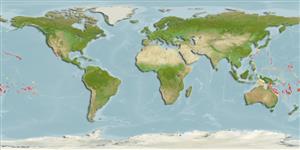Common names from other countries
>
Blenniiformes (Blennies) >
Tripterygiidae (Triplefin blennies) > Tripterygiinae
Etymology: Enneapterygius: Greek, ennea = nine times + Greek, pterygion = little fin (Ref. 45335).
More on author: Fricke.
Environment: milieu / climate zone / depth range / distribution range
экология
морской ассоциированный с рифами; пределы глубины 0 - 30 m (Ref. 54980). Tropical
Central Pacific.
Size / Вес / Возраст
Maturity: Lm ? range ? - ? cm
Max length : 3.3 cm SL самец/пол неопределен; (Ref. 54980)
Краткое описание
определительные ключи | морфология | морфометрия
колючие лучи спинного плавника (общее число) : 14 - 19; членистые (мягкие) лучи спинного плавника (общее число) : 7 - 11; колючие лучи анального плавника: 1; членистые (мягкие) лучи анального плавника: 16 - 20. Short and slender supraorbital tentacle; first dorsal fin 25% shorter than second dorsal fin; female coloration white with black dots, densest on head and posterior half of body, bearing 6 red Y-shaped bars; male live colors unrecorded; lower side of body of male preserved specimens with 5 to 6 large, dark brown triangular marks, joining ventrally, cheeks with many small dark brown spots, and a dark band below the orbit. Dorsal rays III + XI-XVI + 7-11; lateral line interrupted, 15-20 + 15-20; mandibular pores 3-5 + 0-2 + 3-5 (Ref. 54980).
Eggs are hemispherical and covered with numerous sticky threads that anchor them in the algae on the nesting sites (Ref. 240). Larvae are planktonic which occur primarily in shallow, nearshore waters (Ref. 94114). Feeds on small benthic invertebrates (Ref. 89972). Minimum depth from Ref. 58018.
Life cycle and mating behavior
Maturities | размножение | Spawnings | Egg(s) | Fecundities | личинки
Fricke, R., 1994. Tripterygiid fishes of Australia, New Zealand and the southwest Pacific Ocean (Teleostei). Theses Zool. 24:1-585. (Ref. 13227)
Статус Красного Списка МСОП (Ref. 130435)
CITES (Ref. 128078)
Not Evaluated
Угроза для людей
Harmless
Использование человеком
рыболовство: интереса не представляет
дополнительная информация
инструменты
Специальные отчеты
Скачать в формате XML
ресурсы в Интернет
Estimates based on models
Preferred temperature (Ref.
115969): 24.7 - 29.4, mean 27.8 (based on 929 cells).
Phylogenetic diversity index (Ref.
82804): PD
50 = 0.5000 [Uniqueness, from 0.5 = low to 2.0 = high].
Bayesian length-weight: a=0.00562 (0.00258 - 0.01228), b=3.08 (2.89 - 3.27), in cm Total Length, based on LWR estimates for this (Sub)family-body shape (Ref.
93245).
Trophic level (Ref.
69278): 3.1 ±0.3 se; based on size and trophs of closest relatives
устойчивость к внешним воздействиям (Ref.
120179): высокий, минимальное время удвоения популяции до 15 месяцев (Preliminary K or Fecundity.).
Fishing Vulnerability (Ref.
59153): Low vulnerability (10 of 100).
